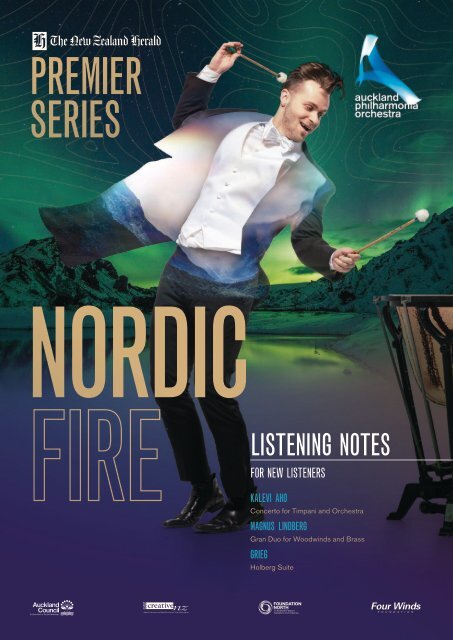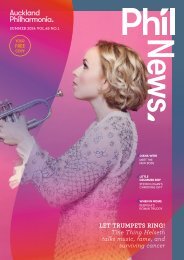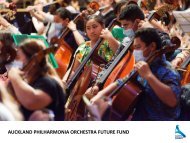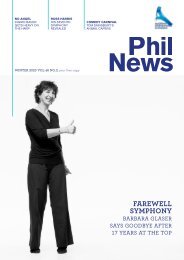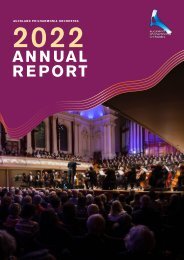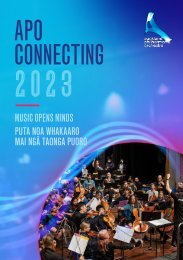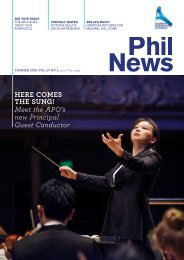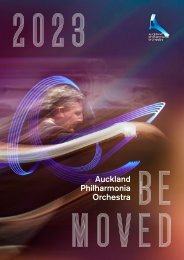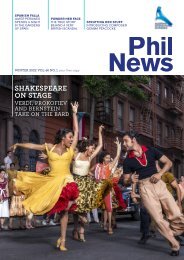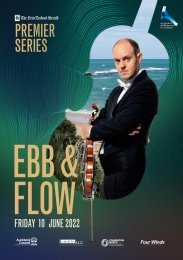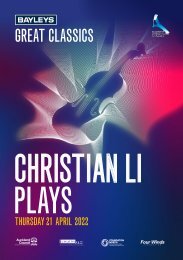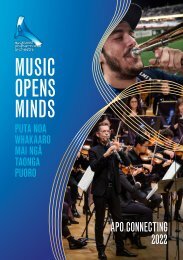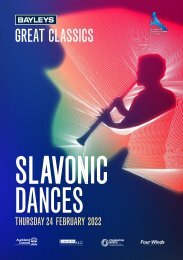Create successful ePaper yourself
Turn your PDF publications into a flip-book with our unique Google optimized e-Paper software.
PREMIER<br />
SERIES<br />
NORDIC<br />
FIRE<br />
LISTENING NOTES<br />
FOR NEW LISTENERS<br />
KALEVI AHO<br />
Concerto for Timpani and Orchestra<br />
MAGNUS LINDBERG<br />
Gran Duo for Woodwinds and Brass<br />
GRIEG<br />
Holberg Suite
KALEVI<br />
AHO<br />
(1949 – )<br />
COMPOSER PROFILE<br />
• Kalevi Aho was born on March 9, 1949, in Forssa in<br />
southern Finland.<br />
• He started learning violin at age ten, which was also<br />
when he wrote his first compositions.<br />
• In 1968, at age nineteen, he studied violin and<br />
composition at the Sibelius Academy in Helsinki.<br />
• He became Professor of Composition at the<br />
Sibelius Academy in 1988.<br />
• In 1993 he left this position, and he has worked as<br />
a freelance composer in Helsinki since.<br />
CONCERTO FOR TIMPANI AND ORCHESTRA<br />
This Concerto is in five movements, with no breaks:<br />
I. Barcarola (the style of a Venetian boat son)<br />
II. Intermezzo. Andante<br />
III. Allegro ritmico<br />
IV. Mesto<br />
V. Presto<br />
<strong>The</strong> first movement opens very softly with a mystical<br />
and airy feeling. This movement is atmospheric and<br />
could almost be an approaching storm, as it builds to<br />
a climax with brass and percussion. However, just as<br />
quickly, it fades to just the timpani using the tuning<br />
pedals to create slides up and down.<br />
<strong>The</strong> second movement, “Slow Interlude”, opens with<br />
the strings and oboe playing a beautiful theme and<br />
timpani accompanying with a rolling pedal note. Once<br />
again, we are transported to a mystical world of<br />
swirling notes and harp glissandi.<br />
<strong>The</strong> third movement, “Fast and Rhythmical”, opens<br />
with percussion and timpani, playing a very rhythmical<br />
ostinato and low brass accenting different notes.<br />
This is broken by ascending scales in the strings<br />
which are answered by the brass. As the “ritmico”<br />
(rhythmical) suggests in the movement name, this<br />
piece is more concerned with rhythms and counterrhythms<br />
than melodic lines.<br />
<strong>The</strong> fouth movement opens with a gong crash and<br />
a harp, once again transporting us into a magical<br />
realm.<br />
<strong>The</strong> final and fifth movement opens with the bass<br />
clarinet playing rapid note runs. This is answered by<br />
more rapid note runs through the winds and strings,<br />
building to a loud section with the timpani, once<br />
again bending its pitch. Suddenly, the music takes<br />
on a much more reflective tone with a gong, church<br />
bells and sustained strings. Again, only the timpani<br />
quietly playing a gentle melody can be heard until<br />
everything fades away.<br />
Aho uses five timpani in his work as opposed to the<br />
traditional four.<br />
DID YOU KNOW?<br />
Aho is also a writer, and he has taken a critical<br />
stand on the cultural politics of Finland.of musical<br />
language to help young children understand pitch<br />
and embody rhythm.<br />
2
MAGNUS<br />
LINDBERG<br />
(1958 – )<br />
COMPOSER PROFILE<br />
• Magnus Lindburg was born on 27 June 1958<br />
• He is a pianist and composer.<br />
• He studied composition at the Sibelius Academy.<br />
• His first composition, “Donor”, a large orchestral work,<br />
was composed at 16.<br />
• In 2016, he composed a companion piece to<br />
Beethoven’s Ninth Symphony, called “Two Episodes”,<br />
premiered at the BBC Proms.<br />
GRAN DUO FOR WOODWINDS AND BRASS<br />
Lindberg has said that he wanted the work to sound “like<br />
an orchestra where the strings didn’t arrive on time.”<br />
At the start, the twofold component in<br />
the title-word Duo is prominent, since the instruments<br />
display themselves in their two distinct families –<br />
woodwind sounding higher and often quite tense, while<br />
the brass effects are deeper and richer.<br />
<strong>The</strong> first title-word Gran (large, combined) holds<br />
increasing sway as the overall sound-picture expands in<br />
range and colour, with different effects created between<br />
the highly profiled, individual lines and the ensemble<br />
effects that evolve as the two instrumental groups blur,<br />
fragment, and regroup into smaller mixtures and solo<br />
lines.<br />
DID YOU KNOW?<br />
After graduating in 1981, he travelled widely in Europe,<br />
attending private studios with Vinko Globokar and Gérard<br />
Grisey in Paris, and observing Japanese drumming and<br />
punk rock in Berlin.<br />
3
EDVARD<br />
GRIEG<br />
(1843 – 1907)<br />
COMPOSER PROFILE<br />
• Edvard Grieg was a Norwegian composer and pianist.<br />
• He came from a musical family. His mother taught him<br />
to play piano from the age of six.<br />
• At the age of fifteen, he went to study piano at the<br />
Leipzig Conservatory.<br />
• In 1897, Grieg performed a private concert at Windsor<br />
Castle for Queen Victoria and her court.<br />
• He was awarded two honorary doctorates, first by the<br />
University of Cambridge in 1894 and the next from<br />
Oxford in 1906.<br />
HOLBERG SUITE<br />
<strong>The</strong> suite is based on eighteenth-century dance forms to<br />
celebrate the 200th anniversary of Danish-Norwegian<br />
humanist playwright Ludvig Holberg. Hence, it can be said<br />
to be neo-Baroque.<br />
It was initially written for piano and then re-orchestrated<br />
for String Orchestra by Greig one year later.<br />
Its five movements are:<br />
I. Praeludium<br />
II. Sarabande<br />
III. Gavotte<br />
IV. Air<br />
V. Rigaudon<br />
<strong>The</strong> first movement, Praeludium, is marked “Very Fast”<br />
and opens with a fast note motif in the violins before the<br />
main theme marked “Sweetly” enters. This fast note motif<br />
reoccurs throughout the piece in various accompanying<br />
capacities.<br />
<strong>The</strong> second movement, Sarabande, is in triple time and<br />
marked “At an Easy Walking Pace”. This has a much<br />
simpler motif with a plainer texture.<br />
<strong>The</strong> third movement, Gavotte, is marked “Fairly Briskly”<br />
and in two time. It has a simple and catchy motif based<br />
on a long note followed by a short. <strong>The</strong> middle section,<br />
called “Musette”, has a distinct drone-like sound from the<br />
lower strings.<br />
<strong>The</strong> fourth movement, Air, is marked “Moderately Slow<br />
and Religious” and has all the features of a Bach Air. It is<br />
in triple time. It’s beautiful, gentle theme is played in the<br />
first violins in a homophonic texture but passed around<br />
the orchestra.<br />
<strong>The</strong> final movement, Rigaudon, is marked “Fast and<br />
Brightly” and is recognisable by its very short note motif.<br />
This has a plucked accompaniment. <strong>The</strong> middle section<br />
is more sustained and lyrical, however still with a plucked<br />
bass. <strong>The</strong> main theme returns and takes us through to an<br />
abrupt ending.<br />
DID YOU KNOW?<br />
In 1909 a recording of the Grieg Piano Concerto was the<br />
first recording of a concerto.<br />
4
LISTENING TO MUSIC<br />
IN A NEW WAY<br />
If you want to develop your ear and listen to music<br />
in a music deeper way, there some elements to<br />
listen out for each time you hear the piece.<br />
1. Pitch or the high or low notes played.<br />
2. Tempo – is the music fast or slow.<br />
3. Dynamics – or the volume of the music.<br />
4. Tone Colour – what instruments are playing?<br />
5. Texture – are many instruments playing at once or<br />
just a few (or just one)?<br />
6. Structure – are themes coming back and repeating<br />
or is the music unpredictable?<br />
Chose one of the pieces to listen to with the following guide:<br />
See how much you can hear.<br />
Element<br />
Description<br />
Pitch Mostly high Mostly low A mixture<br />
Tempo Fast Slow Changing<br />
Dynamics Loud Soft<br />
Tone Colour Strings Brass Woodwind A mixture<br />
Texture Thin Thick<br />
Structure Repetitive Unpredictable<br />
5


